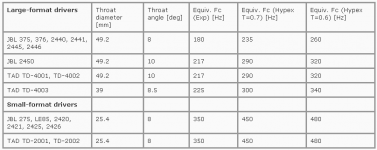Hello all,
This post is to summarise the information that I painstakingly collected over the years on the internal geometries and flare rates of the "classic" JBL and (JBL-inspired) Pioneer TAD compression drivers.
The internal throats are all conical, but based on a hypothetical duct having the same length and entry / exit diameters, and assuming exponential or hyperbolic-exponential (hypex) expansion, one can calculate equivalent cut-off frequencies.
The reason that this is relevant is that for the best possible matching to a horn, one would want the horn (including throat adaptor) to have the same flare rate as the one that actually already starts within the compression driver itself.
The information itself is in the attached table.
I hope someone will find it useful! 🙂
Marco
This post is to summarise the information that I painstakingly collected over the years on the internal geometries and flare rates of the "classic" JBL and (JBL-inspired) Pioneer TAD compression drivers.
The internal throats are all conical, but based on a hypothetical duct having the same length and entry / exit diameters, and assuming exponential or hyperbolic-exponential (hypex) expansion, one can calculate equivalent cut-off frequencies.
The reason that this is relevant is that for the best possible matching to a horn, one would want the horn (including throat adaptor) to have the same flare rate as the one that actually already starts within the compression driver itself.
The information itself is in the attached table.
I hope someone will find it useful! 🙂
Marco
Attachments
- Status
- Not open for further replies.
